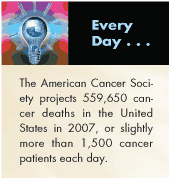Fewer Cancer Deaths 'No Fluke'
Total cancer deaths decreased in the United States for the second consecutive year in 2004, a drop of 3,014 deaths from the toll recorded in 2003. The number of deaths in 2003 declined 369 from the total in 2002.
• ATLANTATotal cancer deaths decreased in the United States for the second consecutive year in 2004, a drop of 3,014 deaths from the toll recorded in 2003. The number of deaths in 2003 declined 369 from the total in 2002. "This second consecutive drop in the number of actual cancer deaths, much steeper than the first, shows that last year's historic drop was no fluke," said John R. Seffrin, PhD, chief executive officer of the American Cancer Society (ACS).
The decline in actual number of deaths for the second year in a row came at a time of continued population growth, including a growing population of elderly people who are most susceptible to cancer. The cancer death rate has dropped by about 1% every year since 1991, but cancer deaths continued to rise (until 2003) due to population growth.
In its annual report on cancer statistics, the ACS put the number of cancer deaths in 2004 at 553,888, which accounted for 23% of all US deaths, ranking it second to heart disease as the nation's leading cause of mortality. The incidence and mortality figures were published in the January/February issue of Ca: A Cancer Journal for Clinicians. (Jemal A et al: 57:43-66, 2007).
"Mortality rates have continued to decrease across all four major cancer sites in men and in women, except for female lung cancer in which rates continued to increase by 0.3% per year from 1995 to 2003," said first author Ahmedin Jemal, DVM, PhD, of the ACS Department of Epidemiology and Surveillance Research.
Although better treatments play a part, the drop in deaths appears to be due largely to reduction in smoking and improvements in cancer screening rates, especially colonoscopy for colorectal cancer. Deaths from colorectal cancer showed the largest drop in both sexes, a decrease of 1,110 in men and 1,094 in females. Overall, for colorectal cancer, the death rate fell by 5.7%. For breast cancer, the number of deaths fell by 666 and for prostate cancer, by 552. For lung cancer, there were 333 fewer deaths in men, but 347 more deaths in women.

"The drops in cancer deaths we're seeing are a cause for celebration . . . But they come at a time of great concern about future progress," said Richard C. Wender, MD, national volunteer president of the ACS. He pointed out that the adoption of tobacco control policies across the country contributed to the drop in deaths, but said that "these gains are threatened by cutbacks in funding for research and prevention programs. A few years after our nation doubled its investment in medical research, Congress cut cancer funding for the first time in more than a decade. I hope today's news shows that the resources spent on this fight have been worthwhile and inspires our lawmakers to recommit to it."
The report also included projections for 2007, with an estimated 1.44 millon new invasive cancer diagnoses. Cancer deaths are expected to total 559,650 in 2007, with the big four (lung, prostate, breast, and colorectal) accounting for slightly more than 50% of the total.
Newsletter
Stay up to date on recent advances in the multidisciplinary approach to cancer.
Elevating the Quality of Cancer Care via Cross-Department Collaboration
Experts from Sibley Memorial Hospital discuss how multidisciplinary work has enhanced outcomes such as survival and resource use at their institution.